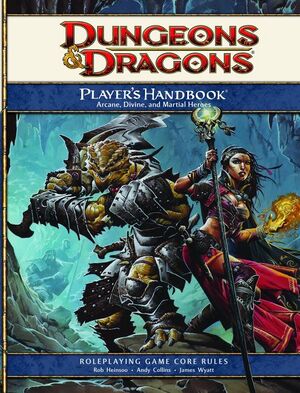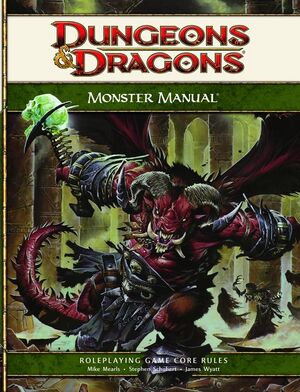Dungeons & Dragons 4th Edition: Difference between revisions
1d4chan>Hanyufag Moved setting stuff to Points of Light. |
1d4chan>Destro No edit summary |
||
| Line 1: | Line 1: | ||
[[Image:4theditionPHB.jpg|thumb|right|Player's Handbook]] | |||
[[Image:4theditionDMG.jpg|thumb|right|Dungeon Master's Guide]] | |||
[[Image:4theditionMM.jpg|thumb|right|Monster Manual]] | |||
The fourth edition of Dungeons & Dragons, the grand daddy of RPGs. | |||
= System = | =System= | ||
= | ==Basics== | ||
Nearly every roll consists of making a single D20 roll, plus a modifier, against a target number. Saving throws have been replaced with Defenses that work like AC; the term 'Saving Throw' is now used to refer to a roll to recover from a durational effect. | |||
= | ==Character Generation== | ||
Chargen is streamlined compared to earlier versions - skills are all-or-nothing, you either have training in them or you don't. Each character gains a selection of Powers which can be used at will, once per encounter, or once per day, in ascending order of power. These abilities often consist of an attack plus some special effect, such as knocking someone prone, setting them on fire, or moving yourself or your opponent. | |||
The character races are: | |||
*Dragonborn | |||
*Dwarf | |||
*Eladrin (High Elf) | |||
*Elf (Wood Elf) | |||
*Half-Elf | |||
*Halfling | |||
*Human | |||
*Tiefling | |||
Character classes in the first PHB consist of: | |||
*Cleric (Healer) | |||
* | *Fighter (Tank) | ||
* | *Paladin (Tank/Healer) | ||
*Ranger (Damage Dealer) | |||
*Rogue (Damage Dealer) | |||
*Warlock (Debuffer) | |||
*Warlord (Buffer) | |||
*Wizard (Crowd Control) | |||
==Gameplay== | |||
Gameplay is divided into Encounters. The GM selects monsters and traps up to a total experience value as recommended for the size of the party, and the encounter plays out as a tactical miniatures game. Non-combat encounters are simplified and consist usually of roleplaying, skill rolls, or a series of skill rolls. XP is awarded for non-combat challenges and quests, as well as for defeating combat encounters. | |||
Each character can take one Standard action (such as an attack), one move action, one minor action, and any number of free actions per turn. Generally each character will use their Standard action to make use of a Power. Characters are highly specialised as noted above, and fit into MMOG-style combat roles of Tank, Healer, Buffer, DPS and so forth. | |||
Characters level up from level 1 to 30; with the scope of the game changing every ten levels. At level 30 characters are expected to undergo some form of apotheosis. | |||
=Setting= | |||
The setting of 4e is highly generic and designed to give the DM a relatively blank canvas to paint on. This default setting consists of a wild medeival landscape in which isolated human and demihuman communities ('Points of Light') struggle to survive after the fall of a greater empire. This provides an explanation for the large areas of wilderness and many ruins for monster to hide in, and the need for adventurers as opposed to more regulated militias. | |||
The DMG contains an extensive section explaining the tropes of the setting and how they might be used, and also suggesting ways in which the GM can deviate from them to make the setting his own. | |||
=D&D 4e on /tg/= | |||
Since its announcement 4e has been a source of controversy and incessant trolling on /tg/. Its supporters consider it to have made D&D simple and fun. Its critics have numerous objections to the system and setting, often referring to it as 'shit twinkie' (with the implication that they had been expecting a certain type of D&D goodness and sorely disappointed by what was actually delivered.) | |||
==Criticism== | |||
Some of the criticisms levelled at 4e include: | |||
*Power-based combat is too similar to MMOGs, in particular WoW. | |||
*The fluff descriptions of the powers are silly. | |||
*There are no Bards/Gnomes/Barbarians/Half-Orcs/Thief-Acrobats/Shitwizards. | |||
*Characters are too durable, reducing the fear of death and TPK. | |||
*Overreliance on unimaginative 'adjectivenoun' naming conventions, for instance: ''Darkleaf Armor: Darkleaves from the gravetrees of the Shadowfell give this armor its protective properties.'' | |||
*Lack of non-combat content such as crafting. | |||
=External Links= | |||
[http://www.wizards.com/default.asp?x=dnd/welcome Official Site] | |||
Revision as of 18:03, 30 June 2008



The fourth edition of Dungeons & Dragons, the grand daddy of RPGs.
System
Basics
Nearly every roll consists of making a single D20 roll, plus a modifier, against a target number. Saving throws have been replaced with Defenses that work like AC; the term 'Saving Throw' is now used to refer to a roll to recover from a durational effect.
Character Generation
Chargen is streamlined compared to earlier versions - skills are all-or-nothing, you either have training in them or you don't. Each character gains a selection of Powers which can be used at will, once per encounter, or once per day, in ascending order of power. These abilities often consist of an attack plus some special effect, such as knocking someone prone, setting them on fire, or moving yourself or your opponent.
The character races are:
- Dragonborn
- Dwarf
- Eladrin (High Elf)
- Elf (Wood Elf)
- Half-Elf
- Halfling
- Human
- Tiefling
Character classes in the first PHB consist of:
- Cleric (Healer)
- Fighter (Tank)
- Paladin (Tank/Healer)
- Ranger (Damage Dealer)
- Rogue (Damage Dealer)
- Warlock (Debuffer)
- Warlord (Buffer)
- Wizard (Crowd Control)
Gameplay
Gameplay is divided into Encounters. The GM selects monsters and traps up to a total experience value as recommended for the size of the party, and the encounter plays out as a tactical miniatures game. Non-combat encounters are simplified and consist usually of roleplaying, skill rolls, or a series of skill rolls. XP is awarded for non-combat challenges and quests, as well as for defeating combat encounters.
Each character can take one Standard action (such as an attack), one move action, one minor action, and any number of free actions per turn. Generally each character will use their Standard action to make use of a Power. Characters are highly specialised as noted above, and fit into MMOG-style combat roles of Tank, Healer, Buffer, DPS and so forth.
Characters level up from level 1 to 30; with the scope of the game changing every ten levels. At level 30 characters are expected to undergo some form of apotheosis.
Setting
The setting of 4e is highly generic and designed to give the DM a relatively blank canvas to paint on. This default setting consists of a wild medeival landscape in which isolated human and demihuman communities ('Points of Light') struggle to survive after the fall of a greater empire. This provides an explanation for the large areas of wilderness and many ruins for monster to hide in, and the need for adventurers as opposed to more regulated militias.
The DMG contains an extensive section explaining the tropes of the setting and how they might be used, and also suggesting ways in which the GM can deviate from them to make the setting his own.
D&D 4e on /tg/
Since its announcement 4e has been a source of controversy and incessant trolling on /tg/. Its supporters consider it to have made D&D simple and fun. Its critics have numerous objections to the system and setting, often referring to it as 'shit twinkie' (with the implication that they had been expecting a certain type of D&D goodness and sorely disappointed by what was actually delivered.)
Criticism
Some of the criticisms levelled at 4e include:
- Power-based combat is too similar to MMOGs, in particular WoW.
- The fluff descriptions of the powers are silly.
- There are no Bards/Gnomes/Barbarians/Half-Orcs/Thief-Acrobats/Shitwizards.
- Characters are too durable, reducing the fear of death and TPK.
- Overreliance on unimaginative 'adjectivenoun' naming conventions, for instance: Darkleaf Armor: Darkleaves from the gravetrees of the Shadowfell give this armor its protective properties.
- Lack of non-combat content such as crafting.